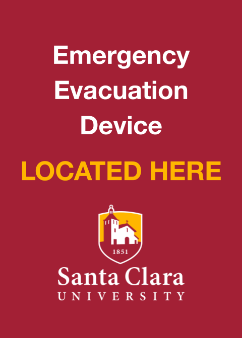If an incident occurs on campus that triggers a building evacuation, use the following guidelines to safety evacuate to the designated Emergency Assembly Point (EAP):
-
Safely stop your work.
-
If you have sufficient time, take personal belongings. Otherwise, leave them.
-
Close door and windows if possible. DO NOT LOCK.
-
Assist visitors and/or others who are mentally, physically or emotionally impaired.
-
Use nearest safe stairs and safe exit. DO NOT USE ELEVATOR.
-
Proceed to the Emergency Assembly Point for your building. Emergency Assembly Points are indicated on Evacuation Maps posted throughout your building.
-
Wait for instructions from emergency responders.
-
DO NOT RE-ENTER building or work area until instructed to do so by authorities. For a campus-wide disaster, Faculty and Staff should report to their Departments, Resident Students to their Resident Halls (then Leavey Center if uninhabitable), Non-Resident Students report to Leavey Center to check-in, and anyone needing shelter reports to Leavey Center.
Campus Emergency Evacuation Devices
There are a number of buildings on the main campus which have emergency evacuation devices installed. The two types of devices are a powered evacuation chair, "Evac+Chair Power 800" and a "QuikLitter™ Lite".
The Evac+Chair Power 800 is a motorized evacuation chair designed to safely transport individuals up or down stairs during emergencies. Battery-powered and easy to operate by one person, it’s ideal for use in multi-story buildings.
The The QuikLitter™ Lite is a lightweight, compact emergency stretcher designed for rapid patient transport. With reinforced handles and a 750 lb capacity, it's ideal for quick deployment in emergencies and mass casualty situations.
Locations where these devices are found are marked by the label below:

Locations are:
Benson Memorial Center (Evac+Chair)
- 2nd floor, West hallway
- Basement level, West hallway
- Basement level, East hallway
Kenna Hall
- 2nd floor, West hallway (QuickLItter)
O'Connor Hall (Evac+Chair)
- 3rd floor, North hallway
Learning Commons and Library
- Basement Level, East hallway
- First floor, East hallway
- Second floor, East hallway
- Third floor, East hallway
Emergency Assembly Points (EAPs)
EAPs are designated areas on campus, which are to be used in the case of emergency situations. They are intended to provide a safe area for individuals while waiting for emergency personnel to respond.
Characteristics of Assembly Points
-
Open areas - a minimum of 40' away from buildings
-
Easily and safely accessible
-
Large enough to accommodate all building occupants
-
Located away from power lines, poles, trees, gas lines and vehicles
-
Accessible to emergency medical personnel
Adjustments may be warranted due to difference in height, size and occupancy classifications of individual buildings. Final determinations on Emergency Assembly Points sites are made by the Environment Health & Safety division manager.
View the Emergency Assembly Point Map.